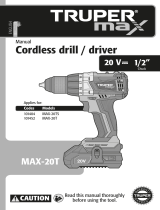Truper CLNE-18 El manual del propietario
- Categoría
- Herramientas eléctricas
- Tipo
- El manual del propietario
Este manual también es adecuado para
Truper CLNE-18 es una clavadora neumática que aplica clavos de entre 3/8" y 2" de largo en madera. Tiene una capacidad de carga de 100 clavos y requiere una presión de operación recomendada de 75 a 110 PSI, con una presión máxima permitida de 110 PSI. Conecta a una entrada de aire de 1/4 NPT y tiene un diámetro interno de manguera de 3/8".
Truper CLNE-18 es una clavadora neumática que aplica clavos de entre 3/8" y 2" de largo en madera. Tiene una capacidad de carga de 100 clavos y requiere una presión de operación recomendada de 75 a 110 PSI, con una presión máxima permitida de 110 PSI. Conecta a una entrada de aire de 1/4 NPT y tiene un diámetro interno de manguera de 3/8".
























-
 1
1
-
 2
2
-
 3
3
-
 4
4
-
 5
5
-
 6
6
-
 7
7
-
 8
8
-
 9
9
-
 10
10
-
 11
11
-
 12
12
-
 13
13
-
 14
14
-
 15
15
-
 16
16
-
 17
17
-
 18
18
-
 19
19
-
 20
20
-
 21
21
-
 22
22
-
 23
23
-
 24
24
Truper CLNE-18 El manual del propietario
- Categoría
- Herramientas eléctricas
- Tipo
- El manual del propietario
- Este manual también es adecuado para
Truper CLNE-18 es una clavadora neumática que aplica clavos de entre 3/8" y 2" de largo en madera. Tiene una capacidad de carga de 100 clavos y requiere una presión de operación recomendada de 75 a 110 PSI, con una presión máxima permitida de 110 PSI. Conecta a una entrada de aire de 1/4 NPT y tiene un diámetro interno de manguera de 3/8".
en otros idiomas
- English: Truper CLNE-18 Owner's manual
Artículos relacionados
-
Truper TPN-711 El manual del propietario
-
Truper CLNEU-2 El manual del propietario
-
Truper COMP-KIT50 El manual del propietario
-
Truper COMP-KIT25 El manual del propietario
-
Truper HILA-2000 El manual del propietario
-
Truper PREM-1 El manual del propietario
-
Truper CALA-A5 El manual del propietario
-
Truper LIRO-5A El manual del propietario
-
Truper CPB-90 El manual del propietario
-
Truper COMBOE-4590N El manual del propietario


























